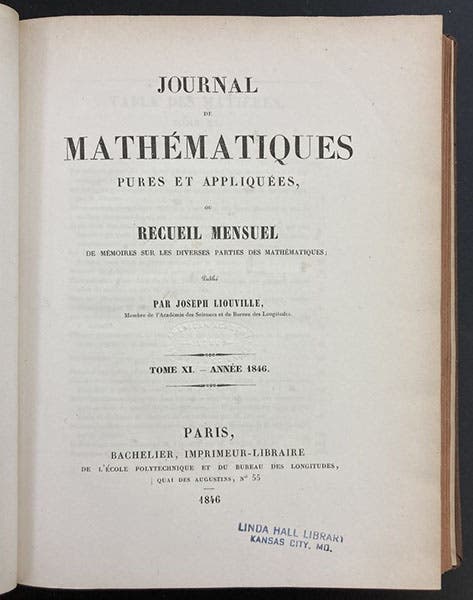Scientist of the Day - Evariste Galois
Évariste Galois, a French mathematician, was born Oct. 25, 1811. If ever a man were the stuff of legend, that would be Galois. The legend, which you will find related in many accounts of Galois’s life to this day, goes as follows: Galois was a brilliant student of mathematics, but his interests were stifled by school authorities. He submitted papers to senior mathematicians at the French Academy of Sciences, but they were mislaid or criticized. Driven by rejection, Galois joined the republicans during the Revolution of 1830 (July Revolution) and participated in the riots. He was arrested and sent to prison. After finally being released, he was challenged to a duel, orchestrated by police authorities, who wanted to get rid of the troublesome young hothead. The night before the duel, Galois feverishly wrote all night, composing several papers. On May 30, the duel took place and Galois was fatally wounded. He died the next day, not yet 21 years old. His pre-duel writings would later form the basis for what is called group theory or Galois theory.
Great story, right? Genius versus stupidity, as Eric Temple Bell put it in his Men of Mathematics (1937), from which the summary above was taken. Youth versus the establishment; innovation versus tradition. Like Thor versus Loki, it does make for a memorable story.
Unfortunately, almost none of the account is true. The legend is almost entirely a fabrication, by Bell and several other historians. Galois was a hothead, and he often acted without any regard to consequences; he seems to have been born without a trace of common sense. And he was brilliant – there is no question of that. But he was never discouraged by school authorities. The papers he submitted, to Augustin-Louis Cauchy and Simeon Denis Poisson were not mislaid or deliberately lost; both men praised Galois’ work, although Poisson found it hard to understand the paper he was reviewing and wanted it clarified. Galois did want to join the republicans at the barricades during the July Revolution (we show here Eugène Delacroix’s famous painting of the events of 1830), but not because his work was discouraged at school; he was always a staunch advocate of liberté and égalité.
The part about Galois desperately writing down all his unrecorded thoughts on the eve of the duel is the part everyone remembers, and the part most blatantly false. The papers Galois is supposed to have written that night had been written long ago, and most had been published in 1829 and 1830 in reputable journals such as the Annales de Mathématiques and the Bulletin des Sciences mathématiques. Galois did write a letter to a friend that night, asking him to publicize Galois’ work should he be killed, as Galois was sure he would be. But he did not spend the night putting group theory down on paper for the first time.
As for the duel itself, there is no evidence for its being a political set-up. It seems rather to have been an old-fashioned affair of honor, involving a woman and a rival. Scholars think they know the identity of the woman, and possibility the rival suitor, but none of this is certain. But no one is surprised that Galois, the definitive man of principle, refused to back down from the threat of death, even though the dispute was certainly frivolous.
Galois’s ultimate fame came the straight-forward way. The letter Galois wrote to his friend on the eve of the duel circulated, along with his papers, to several editors, and in 1843, they ended up in the hands of Joseph Liouville, who edited a respectable serial, Journal de Mathématiques pures et appliquées. Liouville was impressed with Galois’s work. In 1846, Liouville published three of Galois’s papers in his journal, (one for the first time), as well as the letter Galois wrote on May 29, 1832. One of the papers was called (in translation): “On the conditions of the solvability of equations by radicals,” which became an important part of what would be called group theory. We have Liouville’s journal in the Library, and we show here the title page of the 1846 volume and the introduction by Liouville to Galois’s three papers.
Why fabricate such a legend around Galois, when the truth seems remarkable enough? No one really knows. Bell was far from alone in presenting a false Galois to the public. But the fact is, Bell did make up most of the story, and lying is not a good trait to have if you purport to write history. I was given a copy of Bell’s Men of Mathematics in high-school as a prize for doing something prize-worthy, I remember not what. I read and loved the story of Galois. When I later found that most of the story was fabricated, I threw the book away, angry that I had been lied to by someone who had abused my trust. I wish I had kept it, so that I could try to rekindle my feelings of outrage. It would make me feel as close to the always-outraged Galois as I am ever likely to get.
I do not know the source of the pencil-sketch portrait that is used in every account of Galois, and which I have used here. Let us hope it is a valid portrayal. There is a memorial for Galois in Bourg-la-Reine, a commune in southern Paris, but it does not mark his grave, the site of which is unknown.
William B. Ashworth, Jr., Consultant for the History of Science, Linda Hall Library and Associate Professor emeritus, Department of History, University of Missouri-Kansas City. Comments or corrections are welcome; please direct to ashworthw@umkc.edu.











